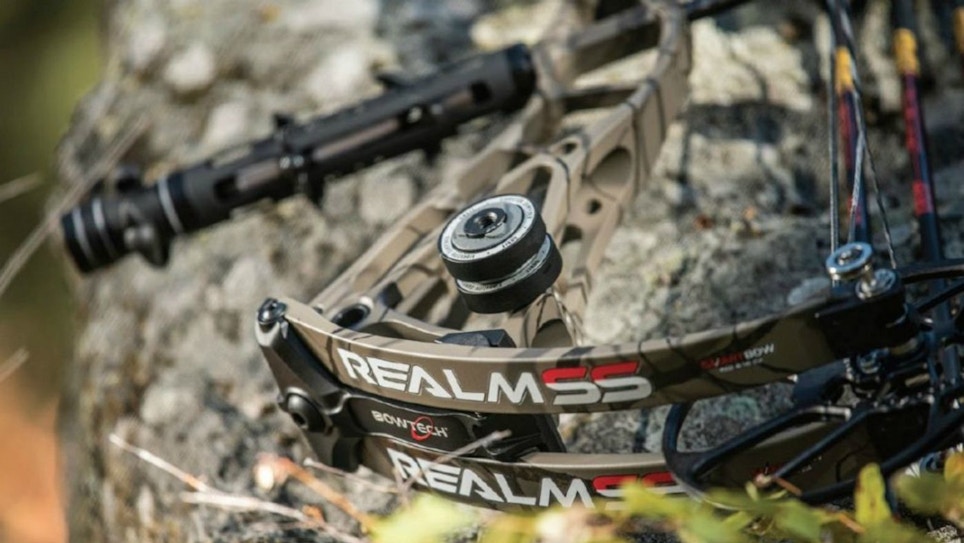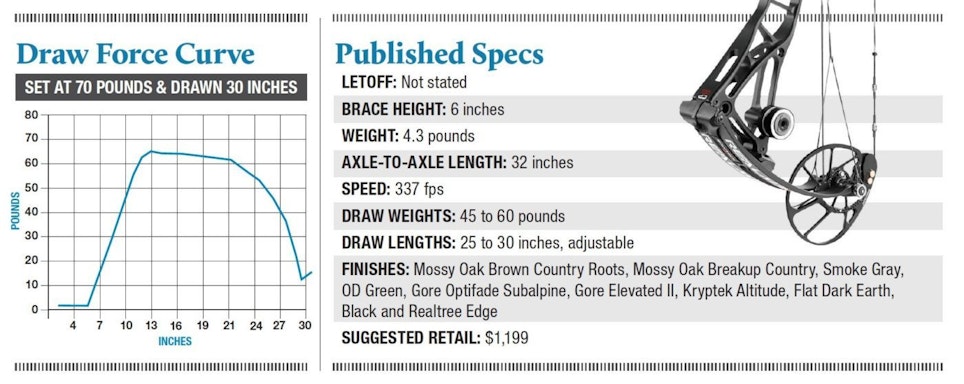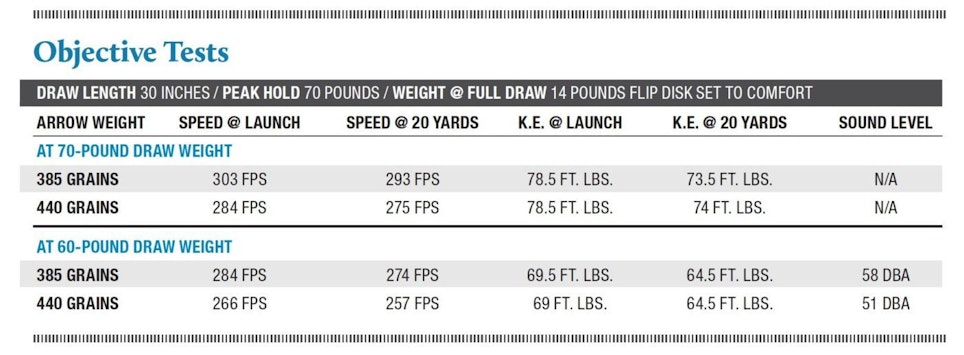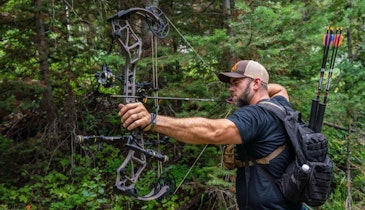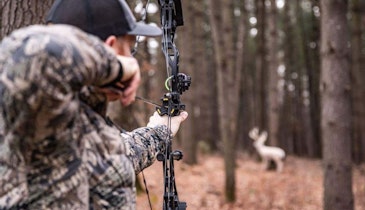Last year, Bowtech introduced the Realm series with the Realm and the Realm X. In 2019, Bowtech added to the Realm series with the SR6 and the SS. The SR6 is an acronym for Speed Redefined, the “6” presumably referencing the 6-inch brace height. At 352 fps the SR6 is a speed bow by any definition, though Bowtech touts it as offering an exceptionally smooth draw cycle despite its high speed. The SS stands for Super Smooth, and offers a top speed of 337 fps — respectably fast, but clearly not what most shooters would consider a speed bow. Bowtech touts it as “The smoothest bow known to mankind” — quite a claim in an era marked by the number of bows esteemed for their smooth-shooting characteristics.
Among the design features shared by the Realm series of bows is Bowtech’s Powershift Technology, consisting of a module that can be easily flipped from a Performance Setting (read higher speed) to a Comfort Setting (read less speed, smoother draw cycle). That gives shooters who opt for any of the Realm Series higher speed bows, or smoother shooting bows, the option to select between slightly higher speed/slightly less smooth-shooting, or slightly less speed/slightly smoother shooting. Most, if not all, of the larger bow manufacturers offer bows within their lineup designed to appeal to those who favor speed and those who favor shootability, but Bowtech’s Realm series might be the only lineup trying to cover that spread with each bow.
More basic than the Powershift system is Bowtech’s Overdrive Binary Cam System. And while it has been tweaked from bow to bow, essentially it is a yoked design that slaves the cams together for consistent timing, while offering precise tunability. A shooter can adjust center rest, then twist or untwist cables to in effect move the cam and tune for his or her particular grip. Added to this high-degree of tunability are numerous threaded openings in the riser — positioned at the top and bottom of the riser, as well as centered and offset — allowing for higher or lower mounting of sights, stabilizers, weights or dampeners, all of which offers the shooter a high-degree of customization in terms of balance, weight and stabilization. All this adds up to a lot of versatility that in the end can contribute to optimum shooting form, maximum accuracy and more enjoyable shooting.
Bowtech’s CP Dual Lock Pockets, FLX-Guard cable guard and skinny Clutch Performance Grip (also customizable in shape and color with optional parts) are now familiar Bowtech design elements. The test bow was black with excellent fit and finish, and more than sufficient durability to pass the scratch test.
Shooting the Bowtech Realm SS
The FLX Guard (or more precisely the rubberized sound dampener on the FLX Guard) made installation of our standard Ultra-Rest with an arrow container a little awkward to install. Apart from this, all our test accessories installed easily and smoothly. Limb bolts were snug but turned smoothly, with no sticking, chattering or slipping. Tuning the bow was straightforward and I was immediately shooting field points accurately; I did tweak a cable to get bullet holes in paper with an unfletched arrow.
I experimented with placing various dampeners and stabilizers in the several different locations available on this bow (though all objective tests were performed with our standard Tru-Glo stabilizer in the traditional spot below the grip on the front of the riser). This does make a difference in terms of balance and steadiness that any target shooter, and some hunters, will appreciate and take advantage of.
Here’s a small but nice touch: draw length settings are labeled clearly with numbers from 25 to 31, instead of requiring that a code be interpreted or tiny holes counted. A non-engineer must have had some input.
Since this bow is touted as the smoothest shooting bow known to mankind, I opted to test it on the Comfort setting of the Flip Disc. I did take a few shots on the Performance setting for a subjective comparison. The switch couldn’t be easier: Just unscrew a module on each cam, flip it over and screw it back in. The draw force curves shows that on the Comfort setting, peak weight is held for a shorter period before dropping off, which accounts for the loss of speed. Subjectively, the difference struck me as noticeable, but not in a big way, and I suspect most shooters will opt for the added speed of the Performance setting. Still, the option is there for shooters who prefer absolute maximum smoothness.
At 4.3 pounds it’s neither a light nor a heavy bow. The grip will appeal to those who, like myself, prefer a skinny, integrated-into-the-riser style of grip. The cage riser and Bowtech’s CP Dual Lock pockets make for a highly rigid, stable bow, which no doubt contributes to the accuracy for which this series is known.
Whether or not the Realm SS is “The smoothest bow known to mankind” is something shooters will decide for themselves, but it is certainly among the more shootable bows currently available. In a lineup of bows noteworthy for offering numerous options and a high-degree of tuning measures and customization, the Realm SS fills a niche for bowhunters who want those qualities and Bowtech accuracy in a reasonably fast, smooth-shooting bow.
For more information, visit www.bowtecharchery.com
How We Test
- Each bow is carefully inspected out of the box for fit and finish and for any visible defects in workmanship. Axle-to-axle length, brace height, mass weight and draw length are measured and compared with stated specs. Minor discrepancies in draw length are corrected or noted.
- A QAD UltraRest is installed, and each bow is equipped with a TruGlo sight, a TruGlo stabilizer, a G5.25-inch Metapeep and a D-loop. Test arrows are Carbon Express Maxima Red arrows at weights of 385 and 440 grains, fletched with Bohning Blazer vanes and fitted with QAD Tune-A-Nocks. Peak draw weight is established, and draw force curves, along with letoff, are determined using an Easton Bow Force Mapping System.
- Using a Spot-Hogg Hooter Shooter bow-shooting machine and a ProChrono chronograph, arrow speed and kinetic energy are measured at point of launch and at 20 yards.
- Sound is measured with an NM102 Sound Level Meter with mic positioned 3 feet in front of the bow and 18 inches under the arrow flight path.
- All bows are pressed on a Buckeye Archery Solutions Bow-A-Constrictor press.
